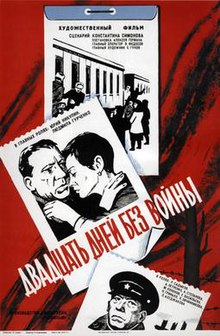Twenty Days Without War
| Twenty Days Without War | |
|---|---|
 |
|
| Directed by | Aleksey German |
| Starring | Yuri Nikulin |
| Cinematography | Valeri Fedosov |
| Distributed by | Lenfilm |
|
Release date
|
|
|
Running time
|
101 min |
| Country | Soviet Union |
| Language | Russian |
Twenty Days Without War (Russian: Двадцать дней без войны, Dvadtsat dney bez Voyny) is a 1976 Soviet film based on a story by Konstantin Simonov, directed by Aleksey German and starring Yuri Nikulin and Lyudmila Gurchenko.
The "Twenty Days Without War" film describes the life of Major Lopatin (actor Yuri Nikulin (1921-1997)), military journalist during World War II, who went to his hometown of Tashkent (Uzbekistan) in Middle Asia at the end of 1942 to spend a 20-day leave following the Battle of Stalingrad and to see the shooting of a film based on his wartime articles he has written, and where he was romantically involved with woman, played by the talented actress Ludmila Gurchenko (1935-2011). The film describes how the romantic views of combat held on the home front are far different from the harsh realities of front line warfare. In the film, he realizes that the romanticized views of warfare on the home front are vastly different from the realities he has encountered. The film was based on the novel and screenplay of Konstantin Simonov (1915-1979), a famous military journalist who wrote the famous poem "Wait for me" during World War II in 1941. The film was mostly shot in black and white, or very muted color, as looking aged to be visually closed to that wartime. As the director, Aleksei German (1938-2013), gave himself and all other crew members, including Cinematographer (Valery Fedosov (1941-1990)), Production Designer (Yevgeny Gukov (1934-1994)), and the Costume Designer (Natalia Toreeva), the enormous task of realistically build all the scenes in the film. All romantic scenes were filmed in Middle Asia, where the real old train was used for connection between the war zone and the home front. The military actions of this film were shot in Kaliningrad on the Baltic sea. The real Baltic Fleet had helped to coordinate military maneuvers where the real military ships were bombed by flying military planes above the ships. The buildings used for background were also the real war damaged bricks buildings, not a set, which were not rebuilt after World War II. And the cold weather also made scenes look more realistically in this film. The winter during which the film was shot, especially with the Baltic sea cold winter and winds, was very good reflected visually the bitter winters as occurred in 1941-1944 during the World War II.
...
Wikipedia
